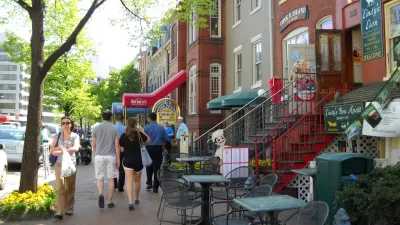A meta-analysis published in Housing Policy Debate finds that extensive studies in recent years support positive claims about walkable neighborhoods.

A review of hundreds of articles and nearly 100 peer-reviewed study finds that compact, walkable neighborhoods "have been found to have significant, positive effects for urban dwellers, in terms of social interaction, health, and safety."
The analysis by Emily Talen and Julia Koschinsky of Arizona State University —Compact, Walkable, Diverse Neighborhoods: Assessing Effects on Residents — was published in the August issue of Housing Policy Debate. Walkable, compact, and diverse (WCD) neighborhoods — Talen and Koschinsky's term — have been heavily studied in recent years, especially in the health field. "Of the 95 examples included in the table, 62 percent were in health journals, 28 percent in planning/design, and 10 percent in transportation," the authors note.
FULL STORY: Walkable neighborhoods improve health, safety, and social life

Study: Maui’s Plan to Convert Vacation Rentals to Long-Term Housing Could Cause Nearly $1 Billion Economic Loss
The plan would reduce visitor accommodation by 25,% resulting in 1,900 jobs lost.

North Texas Transit Leaders Tout Benefits of TOD for Growing Region
At a summit focused on transit-oriented development, policymakers discussed how North Texas’ expanded light rail system can serve as a tool for economic growth.

Why Should We Subsidize Public Transportation?
Many public transit agencies face financial stress due to rising costs, declining fare revenue, and declining subsidies. Transit advocates must provide a strong business case for increasing public transit funding.

How to Make US Trains Faster
Changes to boarding platforms and a switch to electric trains could improve U.S. passenger rail service without the added cost of high-speed rail.

Columbia’s Revitalized ‘Loop’ Is a Hub for Local Entrepreneurs
A focus on small businesses is helping a commercial corridor in Columbia, Missouri thrive.

Invasive Insect Threatens Minnesota’s Ash Forests
The Emerald Ash Borer is a rapidly spreading invasive pest threatening Minnesota’s ash trees, and homeowners are encouraged to plant diverse replacement species, avoid moving ash firewood, and monitor for signs of infestation.
Urban Design for Planners 1: Software Tools
This six-course series explores essential urban design concepts using open source software and equips planners with the tools they need to participate fully in the urban design process.
Planning for Universal Design
Learn the tools for implementing Universal Design in planning regulations.
City of Santa Clarita
Ascent Environmental
Institute for Housing and Urban Development Studies (IHS)
City of Grandview
Harvard GSD Executive Education
Toledo-Lucas County Plan Commissions
Salt Lake City
NYU Wagner Graduate School of Public Service




























